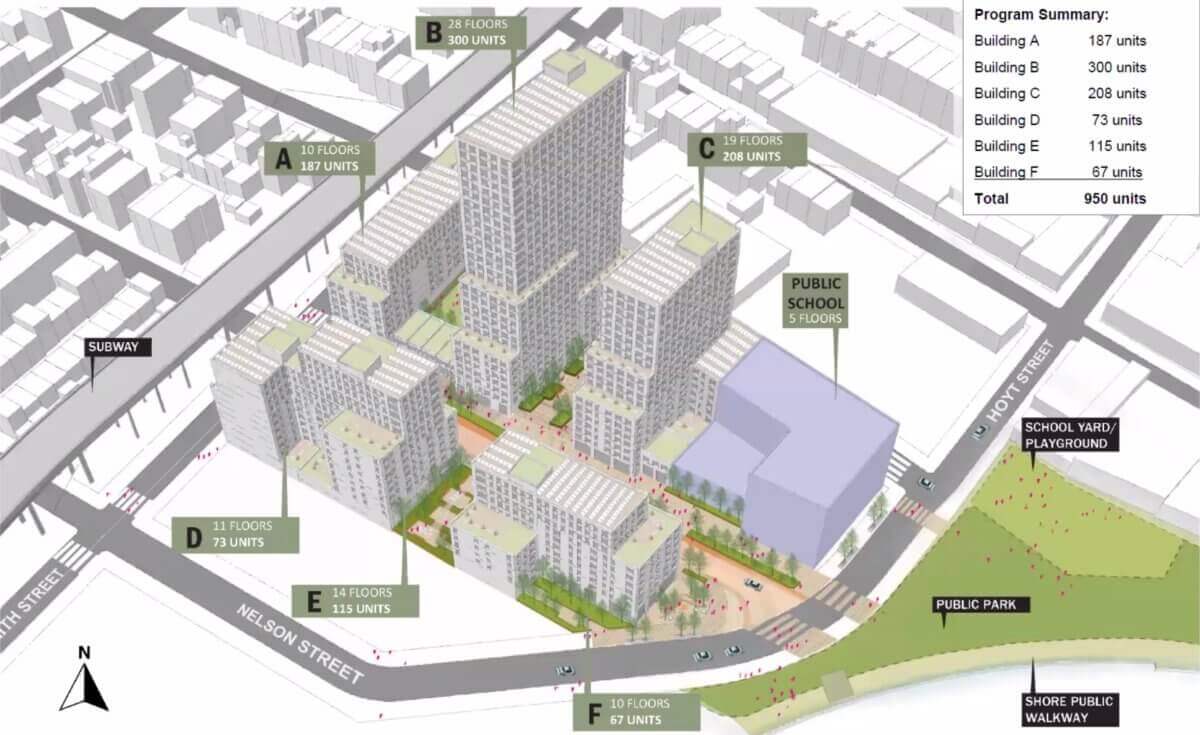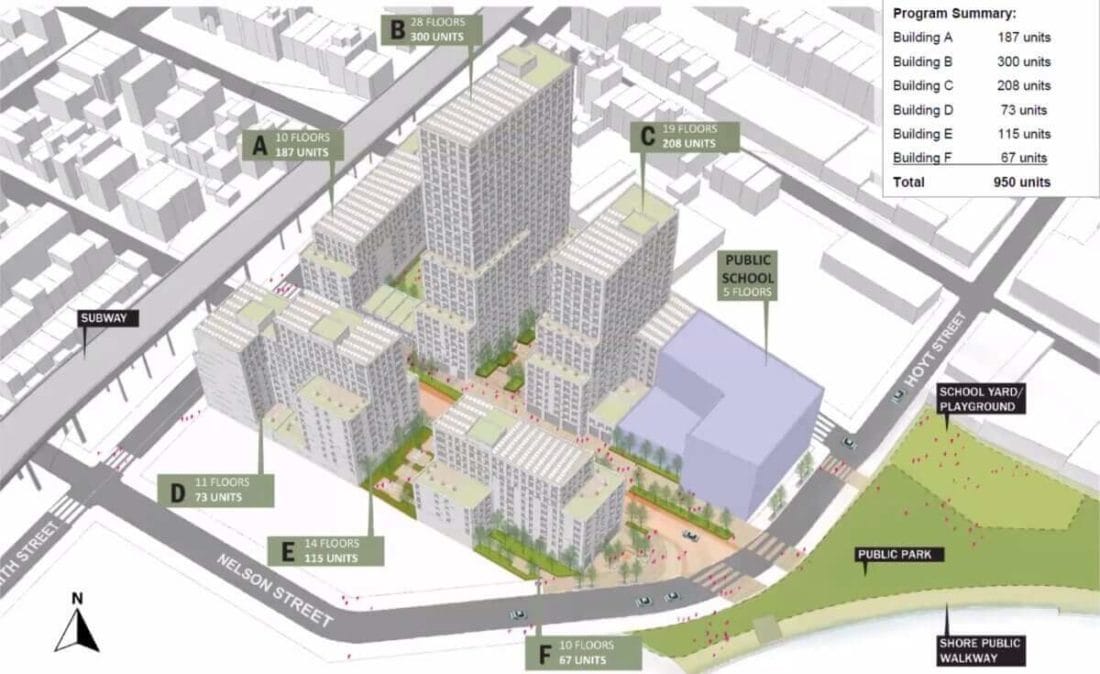OPINION: Welcome to Gowanus Green—Brooklyn’s Own Love Canal


By Linda LaViolette, Miranda Sielaff and Nora Almeida, VOICE of GOWANUS
Advocates of the proposed Gowanus Rezoning claim that a plan to privatize and develop affordable housing on Public Place (Gowanus Green), the site of a former manufactured gas plant, justifies a massive upzoning that will bring more than 6000 luxury apartments to an 82 block swath of south Brooklyn, most of which is in a FEMA flood zone along the banks of a notoriously polluted canal. There are many parts of the Gowanus Rezoning proposal that merit scrutiny, but we believe the plan to house low-income families and build a school on the toxic Public Place site is its deepest flaw.
The Public Place development is at the center of debates about the rezone for good reason. It is at the core of New York City Councilmember Brad Lander’s argument that this rezoning is about racial and economic equity. Conversely, scientists and environmental advocates have warned that there are potentially serious health risks associated with developing housing and a school on this site. Christos Tsiamis, the EPA scientist overseeing the Gowanus canal cleanup who has in depth knowledge of the chemical pollutants in the area, argued at a December 2020 community meeting that current remediation plans are insufficient and could undermine ongoing efforts to clean up the canal. Gowanus residents have since witnessed attempts by city and state agencies to discredit and silence Tsiamis’ environmental and public health warnings.
Environmental activists in Gowanus question whether a plan to house low-income communities of color on toxic land is more about political messaging than racial justice, particularly given the history of environmental racism in New York City. The proposed Public Place development also raises questions about who should bear the economic and regulatory burden of environmental remediation projects and exposes limitations of the New York State (NYS) Brownfield Cleanup Program (BCP). The BCP relies heavily on tax incentives and liability releases for private developers who build on toxic land, often with little transparency and no meaningful community engagement process.
Public Place in Context
Public Place has coal tar deposits from 100 years of manufactured gas production, and also contains waste from other chemical industries and illegal dumping. It is currently being remediated under the BCP, overseen by the potentially responsible party National Grid and the New York State Department of Environmental Conservation (NYSDEC). In spite of the fact that BCPs often fail to meet environmental justice goals, the NYS BCP has funneled more than a billion dollars of tax-payer funding to private developers since its inception in 2003. Largely framed in terms of economic rather than environmental benefits, brownfield remediation efforts often offer little tangible economic benefits to low-income, minority residents in the neighborhoods where they are situated.
Developers, Councilmember Lander, the Department of City Planning, and the Fifth Avenue Committee have renamed Public Place “Gowanus Green” in an effort to greenwash one of the most polluted brownfields in New York State. They position the 950 affordable apartments planned for the site as a move towards equity, while thousands of NYCHA residents living adjacent to the rezone area are still waiting for funding for long promised capital improvement projects. Community members are beginning to wonder if these promises will ever be fulfilled in light of the current fiscal crisis which has already been cited as a reason to delay the construction of sewage overflow tanks (currently slated for completion in 2032) mandated by the EPA’s remedy for the Gowanus Canal Superfund site.
Insufficient Remediation and Public Health Risks
The NYSDEC has already permitted National Grid to scale back the extent of remediation on Public Place, leading environmental activists and members of the Gowanus Community Advisory Group (CAG) to characterize the ‘clean up’ as merely containment–especially troubling given the flood conditions on the site. National Grid acknowledges the contaminants of concern are BTEX (Benzene, Toluene, Ethylbenzene and Xylene), PAHs, cyanide, and metals. With current remediation plans, the toxic pollution on Public Place will remain “significant, and at a depth,” according to EPA representative Tsiamis.
Coal tar deposits, which extend to 150 feet below the surface, will continue to migrate on this former wetland, and no barrier wall is planned between the site and the surrounding neighborhood. On permeable ground, toxic gases will dissipate, but in an enclosed structure (like the proposed housing complexes and school) chemicals can rise and accumulate inside buildings and cause serious health concerns for occupants. The public health risk of building housing on this site is clear: the CDC and National Institutes of Health have linked prolonged exposure to BTEX pollutants through air vapors directly to increased cancer rates and blood disorders.
Environmental Justice and Community Input
Unlike other aspects of community planning and development, brownfield remediation decisions and processes often happen without any community involvement. Instead, cleanup plans are usually determined as part of a site-specific redevelopment process that includes only the state regulatory agency, responsible parties, and developers. Urban planning scholars have noted that in particular, “racial minorities and lower income residents are often excluded in governmental environmental decision-making processes, a fact that raises concerns about procedural justice” especially for a site like Public Place that is designated for low-income families.
The environmental justice (EJ) movement provides an important lens to examine the Public Place proposal, both because of historic intersections between environmental, social, and racial justice struggles and because of the framing of the Public Place proposal by rezoning proponents as a project that is fundamentally about equity. The principles and practices that have defined EJ struggles–those of self-determination, transparency, and community involvement–are fundamentally at odds with the current NYS BCP.
The State Environmental Quality Review Act does not require compliance oversight, and the only recourse is through community-led litigation. Low-income communities lack funding for lawsuits, and if the site were managed as a public-private partnership such as NYCHA’s RAD-converted properties, the tenants’ legal rights would be diminished further. Scholarly research and the direct experience of communities of color facing environmental injustices both support the conclusion that the NYS BCP may prevent the state from heeding the community’s concerns in the case of Public Place.
Alternative Plans
Public Place must be remediated and monitored in perpetuity regardless of its future use, but without a full removal down to bedrock, significant toxins will remain. Given the potential for public health risks and ongoing contamination of the Gowanus Canal, environmental activists and community members call for full remediation, community input for the cleanup process, and for community power in shaping alternative plans for the site. The Gowanus Lands alternative proposal for a park on Public Place is one option that would pose less danger to current and future residents. A Superfund designation for Public Place could also provide a framework for community input and ensure compliance with federal standards. Perhaps these solutions wouldn’t provide as much profit for real estate developers, but they would certainly avoid a Love Canal in Gowanus.
Environmental activists Nora Almeida, Linda LaViolette and Miranda Sielaff are Gowanus residents and members of the community group Voice of Gowanus.




